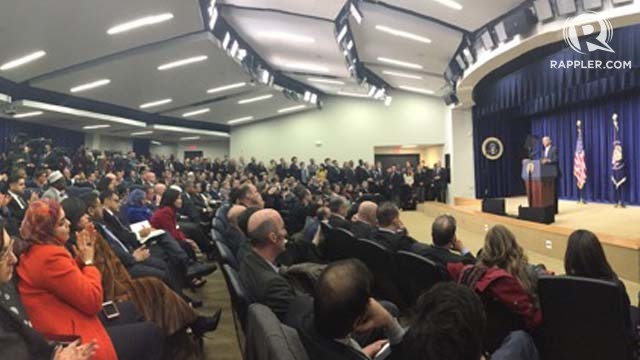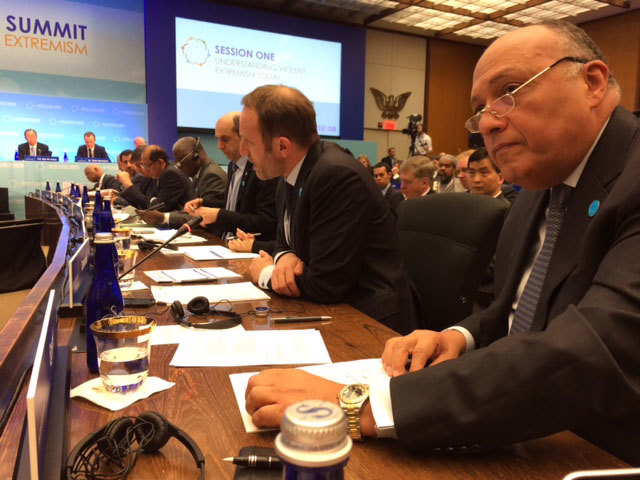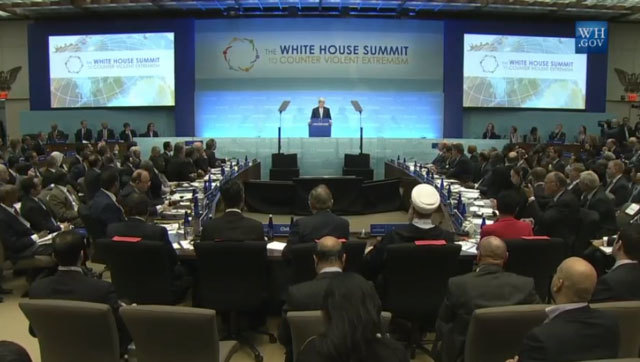The White House Summit on Countering Violent Extremism mobilizes community partners, religious groups, academic institutions and the private sector to create a counter-terrorist environment

TURNING POINT. The White House Summit on Countering Violent Extremism. Photo by Maria Ressa/Rappler
The idea is simple: fight the recruitment and propaganda of ISIS, the Islamic State of Syria and Iraq, by building strong communities that protect youth around the world in the physical and virtual worlds, where ISIS has been winning the battle on social media.
Leading that charge is the United States, which convened a 3-day summit in Washington, DC last week with at least 60 countries, many which have suffered attacks spurred by ISIS’ global rise. The US estimates that at least 20,000 fighters have been lured by ISIS in a little more than 3 years, far more than the 10,000 who fought in Afghanistan in a decade of conflict that spawned al-Qaeda.
The summit took place just days after an ISIS-affiliated group beheaded Egyptian Christians in Libya and an attack in Copenhagen. The global spread of this threat, which has turned home-grown in many cities, is apparent and alarming – from Boston, USA to Ottawa, Canada to Paris, France to Peshawar, Pakistan and many more.
That, say US officials, is the reason for the White House Summit on Countering Violent Extremism or CVE, the largest effort so far to unite governments, private sector and civic society groups globally on a “bottom-up approach” to fighting the evolution of the virulent ideology behind terrorism.
CVE is a discipline used in many countries around the world that aims to prevent terrorism where it begins: the radicalization of young people in communities. It tries to undermine the attraction of violence through 3 ways: by "building awareness, countering extremist narratives, and emphasizing community-led intervention."
Other countries like Singapore, which began its CVE initiatives in 2003, and Australia, which has a government CVE arm, have long worked with communities, but the US summit signaled the beginning of a global whole of society approach to battling terrorism.
“The White House summit is a turning point in the fight against terrorism,” said Rohan Gunaratna, author of Inside al-Qaeda and the head of the International Centre for Political Violence & Terrorism Research in Singapore. “For the first time, the United States is mobilizing community: community partners, religious groups, academic institutions, and the private sector to create a counter-terrorist environment.”
Gunaratna pointed out that the US had long focused on a military and law enforcement response against al-Qaeda. The rise of ISIS, he said, is changing that. “The US realized it has no option but to work with the community because the predominant form of attack of ISIS is to radicalize communities, splinter them and recruit their members to carry out the attacks,” he added.
In the Asia-Pacific, Australia seems to have seen the most number of its citizens radicalized by ISIS. On Monday, February 23, Australian Prime Minister Tony Abbott announced tougher, new measures to counter terrorism. Australia has been on high alert since September. Since then, about 20 people have been arrested in ISIS-related terrorist plots. The last two were arrested mid-February.
“We’ve seen a heavy-handed approach to terrorism, and rightly so, but it’s not been balanced out by the soft approaches so our work is 10 times harder when we work with communities,” said Anne Aly, a Muslim academic and founder of People Against Violent Extremism or PAVE in Perth, Australia. “I’m not one to be alarmist, but every day, I’m meeting a new young person who’s being radicalized and is going down that path. The threat has grown a lot.”
Two days of dialogues at the White House, capped by a 3rd day of Ministerial meetings at the State Department mixed government leaders with the academe, civic-society groups like Washington-based Muflehun, Hedayah from Abu Dhabi, PAVE from Australia and with private sector leaders like Microsoft, Google, Accenture, the Acumen Fund along with a startup like Rappler.
Nearly every speaker mentioned the Internet and social media, and how so many of their youths have been radicalized online. One Muslim cleric talked about how ISIS’ social media engagement began in the morning and continued late into the night: it is personal and it targets vulnerable youth.

Because we were all in the same room, quick connections and shared ideas sparked animated conversations – civil society quickly connecting with ministers, who could put ideas into action.
"The quality of participation in this conference was tremendous – from ministers to state ministers to heads of security and intelligence services to organizations in the private sector," said Gunaratna. "You can see that there will be more resources, more focus, more direction."
The only journalist to speak from a startup that built its growth on social media, I sat between Syrian cleric Sheikh Mohamed Yakoubi and Egypt’s foreign minister Sameh Shoukry on the week that Egypt launched an airstrike against ISIS forces in Libya to retaliate for the brutal beheadings of Egyptian Christians.

Egyptian Foreign Minister
“The barbaric violence they commit is totally out of line with any form of human values,” Egypt’s foreign minister Shoukry told me during the first break. “It’s very clear whether it’s ISIS or any other terrorist organization that perpetuates violence and puts innocent lives at risk is a terrible plague that has to be eradicated and defeated. It has to be dealt with comprehensively.”
That was echoed by US President Barack Obama, who gave two policy speeches during the summit outlining his government’s key messages: reject sectarian strife; separate terrorists from Islam; address grievances, including political and economic ones, that lead to marginalization; give the youth opportunities; and, avoid “us” and “them” by building inclusive communities.

"We have to ensure that our diverse societies truly welcome and respect people of all faiths and backgrounds, and leaders set the tone on this issue," said President Obama. He set a timeline.“At the United Nations in September, I called on the international community to come together and eradicate violent extremism. And I challenged countries to come to the General Assembly this fall with concrete steps we can take together. And I’m grateful for all of you for answering this call.”
National Security Advisor Susan Rice outlined concrete actions: how President Obama “has requested nearly $400 million for the State Department to support a wide range of partnerships to counter terrorism.” Working with the US Agency for International Development (USAID), the State Department said that dealing with today’s threats is “a generational challenge” and that “lasting victories” are not found in the battlefield, but “in mindsets, and within communities, schools, and families.”
The State Department set out concrete steps for the coming days, and asked their allies to join them. “We need to discredit extremist ideologies, address the economic and political grievances that can feed extremism, empower local communities while remaining true to our values,” said Rice.
Still, many who attended said that the US is late coming to the table – something US Foreign Secretary John Kerry admitted, talking about his conversation with a minister from a country in northern Africa, “where young people are just proselytized and captured at a very young stage, paid money in some cases.” It’s a process of indoctrination that is made more potent online.
“What was chilling was this foreign minister said to me, they don’t have a five-year strategy; they have a 35-year strategy,” said Kerry. “So we have to come together and say, ‘What’s our strategy? How are we going to respond.’”
ISIS' online domination
Finding the way forward wasn't always easy. Even finding a common name for ISIS was difficult: it was referred to by at least 4 different names: IS, ISIS, ISIL and Daesch, a loose Arabic acronym for the group.
Discussions were complex, messy, triggering many sensitivities. Yet, on many points everyone agreed: the threat can only be dealt with effectively by working together; that the Internet and social media battle has so far been dominated by ISIS; and that the work to protect the youth begins in communities, and must include women.
Much of what was accomplished in the 3 days failed to make it to American media coverage, where the term CVE was rarely used. Television, dominated by pundits stuck in a black and white threat landscape, focused on why the US wanted to separate terrorism from Islam. Others focused on whether the US was going soft on terrorists.
“There’s been a silly debate in the media in the last days about the sort of … what you have to do,” said Kerry.“You have to do everything. You have to take the people off the battlefield who are there today, but you’re kind of stupid if all you do is do that and you don’t prevent more people from going to the battlefield.”
It is time to break silos of disciplines, to break differences of philosophy over governance: after all, some of America’s best allies in counterterrorist operations are also some of the ones who have violated some of its principles of democracy and human rights, like Egypt.
“We see the interconnectivity and mutual support,” Egypt’s foreign minister Shoukry said. “We see them moving from Nigeria into Mali, into Chad, into Libya. We see the weaponry that they exchange. We see the financial structures that they present, and the recruitment strategies that help them enhance their capabilities. We know we need to deal with the political conditions that might help them recruit, that might provide space for them to operate because of dissatisfaction and disenfranchisement.”
This is enlightened self-interest at its best: a major policy-setting global summit that showed a United States experimenting with its new role for a networked and fragmented world facing a threat that has evolved significantly since 9/11.
“We are here today because we are united against the scourge of violent extremism and terrorism,” said President Obama. “We are all in the same boat. We have to help each other.”
Part 2: How to fight ISIS on social media
[Maria A. Ressa is the author of Seeds of Terror: An Eyewitness Account of Al-Qaeda's Newest Center of Operations in Southeast Asia and 10 Days, 10 Years: From Bin Laden to Facebook.]
http://www.rappler.com/newsbreak/in-depth/84803-fight-isis-build-communities

No comments:
Post a Comment
Note: Only a member of this blog may post a comment.